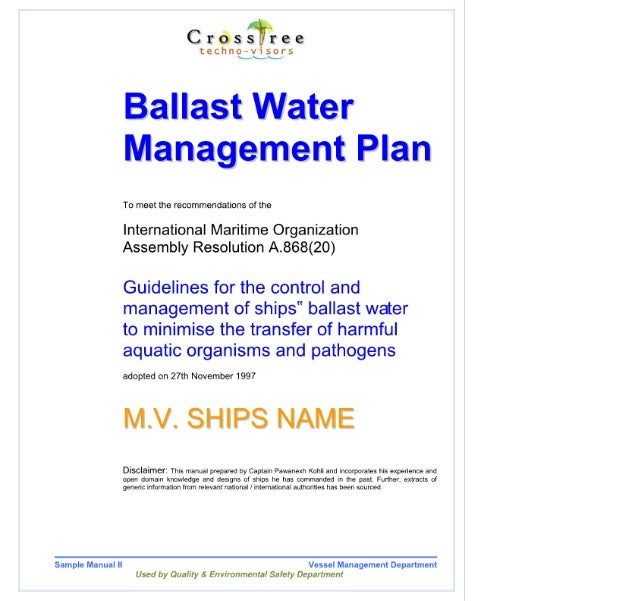
ClassNK EQD as of 27 July 2018 BWMS Manufacture BWMS Name Country Process Capacity of Approved BWMS Basic Approval Final. Latest Information of Approval of Ballast Water Management System Approval of Active Substances G9 (MEPC169(57)) Approval given by IMO Approval of BWMS G8 (MEPC174(58)) Approval given by the. US Ballast Water Management Requirements B allast water management in the United States is administered by both the US Coast Guard (USCG) and the US Environmental Protection Agency (EPA). Worldwide owners/operators, naval architects, marine engineers and regulatory bodies have requested clarifi cation of.
In order to reduce damage from aquatic invasive species the International Maritime Organization (IMO) developed the “International Convention for the Control and Management of Ships' Ballast Water and Sediments”.
The BWM convention began with the IMO’s Marine Environment Protection Committee (MEPC) in 1991. Since then there have been many revisions.
Some of these revisions were driven by advancing technology to remove unwanted organisms at flow rates that would not severely impact operations.
Treatment of ballast water with the latest technology can meet standards at a rate of 2500 cubic meters (660,430 US Gallons) per hour. A large vessel may still take several hours per exchange to flush her ballast tanks at this rate.
Flow rates and energy consumption must be acceptable to operators while producing no harmful effects on the environment.
Ballast Water Management System
Ballast Water Standards

There are two types of ballast water standards in the convention. Their differences are significant and they should not be directly compared.
The first, Ballast Water Exchange, is based on specified distances and depths where a vessel may discharge.
Ballast Water Management Certificate
Ballast Water Performance is a standard based on the number of viable organisms allowed per unit of treated water.
Some areas are instituting standards which exceed the IMO guidelines. Both California and the Great Lakes region of the United States have adopted stringent local guidelines. The US is one of many major shipping nations that have not signed the convention.
Thirty nations who have a combined merchant gross tonnage of thirty-five percent of the global tonnage are needed to ratify the convention.
Ballast Water Management Manual
Ballast Water Exchange
The standard for ballast water exchange is fairly simple. A vessel must discharge foreign ballasts at a specified distance from shore and at a specified depth using a submerged discharge device.
Regulation B-4 and D-1 of the BWM convention gives us the specifics.
- Exchange may take place 200 Nautical Miles (NM) from shore at a depth of 200 meters. If that is not possible for safety or other reasons then a vessel may use the next procedure.
- If neither of these scenarios is possible then a vessel may exchange “in an area designated by the port state”. While undertaking ballast water exchange a port state must not cause deviation or delay of a ship.
- Efficiency of exchange should be at least 95% of volume and must be repeated three times. Vessels which demonstrate high-efficiency exchanges may reduce the number of exchange cycles.
- Ballast Water Exchange should only be undertaken when the safety of the vessel and crew are guaranteed.
Ballast Water Performance
In the case of Ballast Water Exchange, ship operators are flushing untreated ballast out of the tanks. This is a practical if not perfect way of allowing older vessels to operate without the expense and logistical problems of ballast water treatment retrofits.
New and retrofitted vessels are much less likely to transport unwanted species because the ballast water treatment systems eliminate a large proportion of the viable organisms from the ballast tanks before discharge.
Systems like these significantly reduce the chances of unwanted species being introduced by inefficient exchange practices or in the event of an untreated near shore discharge for safety reasons.
The IMO uses the following guidelines for the Ballast Water Exchange standard in regulation D-2.
- Ballast water must contain less than 10 viable organisms which are greater than or equal to 50 microns in size per cubic meter (264 US Gallons). For reference, 50 microns is about half the thickness of an average human hair.
- In addition, ballast water must contain less than 10 viable organisms that are less than 50 microns but greater than or equal to 10 microns per milliliter (1/1000th of a liter).
- Indicator Microbes may not exceed the following amounts; Vibrio Cholerae - less than 1 CFU (colony forming unit) per 100 Ml, E. Coli – less than 250 CFU per 100Ml, Enterococci – less than 100 CFU per 100Ml.
Ballast Water Management Convention
Water treated to this standard is considered pure enough to discharge in most ports. These steps to re-mediate ballast water are only effective in the removal of unwanted organisms. It is still possible to carry toxins like copper and heavy metals often found in ports to other destinations in ballast water and these pollutants may concentrate in ballast tank sediment. Radioactive substances can also be transported in ballast but any serious cases would likely be found quickly by monitoring personnel.